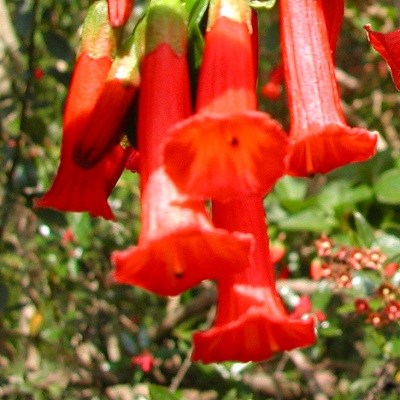Red Iochroma Germinating the seeds
Plant your seeds when you receive them for best results Getting started -- Use small containers or cups that have drainage holes. Fill them with a well draining mix, such as 2 parts potting soil to 1 part perlite or coarse sand. An alternate mix is equal parts of coir fiber and perlite, with some slow-release fertilizer added. After filling the containers with soil, water them, then place a seed or 2 on top. Next sprinkle some water on the top soil layer to settle the seeds into the cracks in the soil. Light helps the seeds germinate, so don't bury them deeply. Until the seeds sprout, ensure that the soil surface does not dry out and the surrounding air is almost 100% humidity. To maintain moisture, you may enclose the pots in a plastic dome or bag. Leave it open a crack to allow some fresh air in. You may need to drip some water on the soil every day to keep it moist. Keep the pots between 65-75 degrees F (18-24°C). A slight drop in temperature at night is ok. Avoid letting them get above 78°F (26°C) for prolonged periods. I recommend placing a minimum/maximum thermometer near the pots, to ensure that the seeds stay the right temperature. Keep the pots in a bright spot out of direct sun. A fluorescent bulb kept 5 inches (12 cm) above the soil provides the right amount of light. The seeds can sprout at varying times, with some sprouting at 4-6 weeks, and others at 10-12 weeks. Continue keeping the soil surface moist the first 3-4 weeks after sprouting, then let the surface dry out between waterings. Continue giving bright, indirect light for the first month. I recommend growing them indoors until they are 8 inches (20 cm) tall. Watering - Aim to keep the soil evenly moist most of the time. Don't let the soil dry out completely, and don't let them sit in a tray of water. If your tap water is very high in minerals ("hard" water) it may be best to use bottled water or rain water. Repotting - When the plants are 2-3 months old, transplant them to a larger container. Transplant carefully to avoid letting the soil ball break apart, which can damage the roots. Watering the soil before repotting can help avoid this. For the first week after repotting, give no direct sun. Feeding - The plants like soil of good fertility. Feed about every 2 months during the growing season with a slow-release (pelleted or organic) fertilizer. If your potting soil contains fertilizer (check the label), your seedlings shouldn't need feeding the first 2-3 weeks. It's normal for an older leaf to occasionally turn yellow and drop, but if it seems excessive, your plant may need more nitrogen fertilizer. Or the soil may be too dry down in the root zone. Keep in mind that the leaves normally drop each winter if temperatures are cool enough. Sunlight & climate -- Red Iochroma likes part sun to full sun. In hot areas, it's best to give it some afternoon shade. I recommend protecting the plant from freezing temperatures. It can drop its leaves from light frosts, but reportedly can come back from the roots on mature plants after freezes of 25°F (-4°C), if mulched well. Iochroma won't flower if the weather is too warm. Don't grow it where heat can accumulate, like near a sunny wall. It flowers best with cool nights (45-65°F), and daytime temps of 55-80°F. Over about 40% humidity is recommended. Indoors, if your humidity is too low, you may use an ultrasonic room humidifier, which you can get from thrift stores or home improvement stores. Pruning -- Pruning isn't necessary except to shape it. Like most bushes, cutting back the tallest stem will encourage lower branching, and, likewise, removing lower branches will encourage upward growth from the main stem. Avoid removing too much foliage at one time. Pests to watch for -- Spider mites (tiny "dots" under the leaves), Aphids, whitefly If you have any questions or problems, please email me. Have fun growing them! - Jeff Strange Wonderful Things
|
|||||||||


